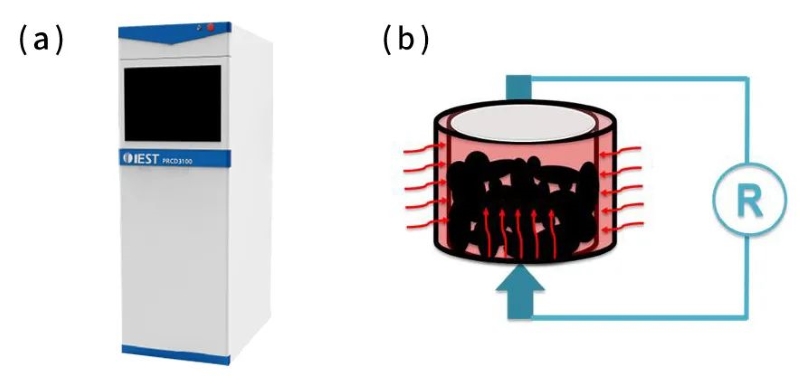Temperature-changing conductivity testing and activation energy calculation of positive and negative electrode materials and solid electrolytes
Temperature characteristics of lithium-ion batteries are a very important part of battery technology research. Temperature has a significant impact on the performance and life of lithium-ion batteries, so studying the temperature characteristics of lithium batteries is essential to achieve efficient, safe, and long-lasting battery operation. The temperature characteristics of the battery are the result of the interaction of multiple components of the battery's internal materials (such as positive electrode, negative electrode, separator, electrolyte, etc.). However, using the lithium-ion battery to evaluate the temperature characteristics of the system can only obtain regular tests, and cannot analyze it in principle and make subsequent improvements; therefore, the temperature characteristics of different component materials are tested separately, and different components are established. The connection between components is a necessary way to deeply understand and analyze the temperature characteristics of lithium-ion batteries, and it also provides effective means and data support for optimizing and improving temperature characteristics.
Activation energy (Ea) is generally used to define the energy barrier that needs to be overcome for a chemical reaction to occur. The energy required for a molecule to change from a normal state to an active state prone to chemical reactions is called activation energy. This concept was proposed by S.A. Arrhenius of Sweden in 1889 based on a summary of many experimental facts. and obtain an empirical formula.

For first-order reactions, activation energy can be used to represent the minimum energy required for a chemical reaction to occur, and its size can reflect the difficulty of the chemical reaction, at the same time, activation energy can also represent the energy required for crystal atoms to leave the equilibrium position and move to another new equilibrium or non-equilibrium position. For example, the energy that needs to be overcome to start a certain physical and chemical process (such as plastic flow, electron/ion diffusion, chemical reaction, hole formation, etc.). This energy can be provided by the energy fluctuations of the system itself or by the outside world. The smaller the activation energy, the easier the process is to carry out.
Therefore, establishing effective testing and characterization methods to study the temperature characteristics of different component materials of lithium-ion batteries, combined with relevant theories of activation energy, can analyze and improve the temperature characteristics of lithium-ion battery-related materials in principle; At the same time, it also provides reliable data support required for simulation calculations for relevant theoretical calculation R&D personnel.
1.Experimental Equipment and Testing Methods
In lithium-ion batteries, the electrodes are a mixed conductor of electrons and ions (solid particles of the active material and conductive agent conduct electrons, and the electrolyte conducts ions), while the separator or solid electrolyte is mainly an ion conductor. In this article, the powder resistivity & compaction density meter PRCD3100 independently developed by IEST is used. This device is equipped with a newly developed temperature-raising device to test the electronic conductivity of different materials at different temperatures. In addition, with the testing system independently developed by IEST for solid electrolytes, solid electrolyte sheets can be pressed continuously and stably. With an external electrochemical workstation, the ionic conductivity of solid electrolytes at different temperatures can be tested in situ.
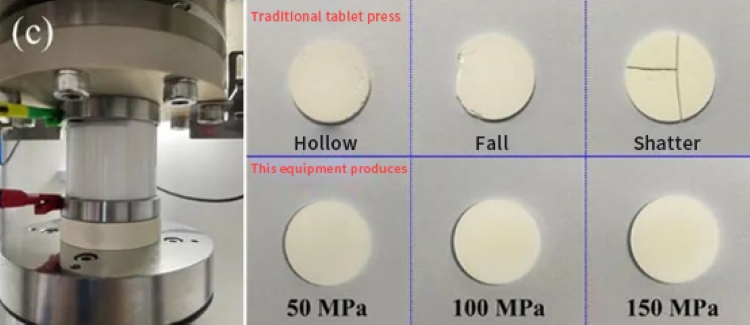
Figure 1. (a) PRCD3100; (b) temperature increasing device; (c) solid electrolyte testing system
2.Results Analysis
The powder resistivity test of lithium iron phosphate (LFP) material was carried out at different temperatures in the pressure range of 10~200MPa. As shown in Figure 2(a), under different pressures, the resistivity decreased with the increase of temperature. And the changing trends of resistivity with increasing pressure are similar at different temperatures. Combined with the analysis of Arrhenius formula, we can take the logarithm of Arrhenius formula to get:

Bring the rate coefficient k in the formula into the conductivity and get the relationship between conductivity and temperature. By testing the conductivity of the material at different temperatures, the slope and intercept can respectively correspond to the activation energy (Ea) and pre-exponential factor (A) after linear fitting.
Select powder resistivity data at different temperatures under the same pressure, calculate the conductivity, and then combine the Arrhenius formula to make the corresponding linear fitting curve of lnσ and 1/T. Further calculations can obtain the corresponding activation energy (Ea). As shown in Figure 2 (b), in addition to LFP, we also tested the electrical conductivity of ternary materials (NCM) and graphite (Graphite) at different temperatures, according to the Arrhenius formula, the activation energy and pre-exponential factor were calculated separately. The calculated results are shown in Table 1. From the comparison of activation energy indicators, lithium iron phosphate has the largest activation energy, about 0.116eV; the activation energy of ternary materials is slightly smaller than lithium iron phosphate, about 0.041eV; the activation energy of graphite materials is the smallest, about 0.025eV. The above results show that among the three materials, the energy that electrons need to overcome for transmission in graphite material is the smallest, followed by the ternary material, and the energy that needs to be overcome for transmission in lithium iron phosphate material is the largest.
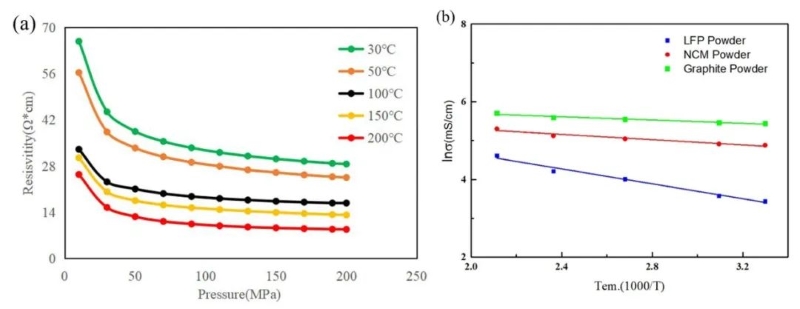
Figure 2. (a) Resistivity of LFP powder between 10 and 200MPa at different temperatures;
(b) Arrhenius plot of conductivity versus temperature of different positive and negative electrode materials.
The electronic conductivity of battery electrodes is one of the key factors that determine the performance of lithium-ion batteries. Typically, an electrode sheet contains active material, conductive carbon, and a binder. In the current research, the impact of the type and proportion of the conductive agent in the electrode piece on the electronic conductivity of the electrode piece is mainly considered. Especially for the positive electrode, since the electronic conductivity of the active material is very low, conductive additives are used to ensure good electronic conductivity. However, in high-energy batteries, the levels of conductive carbon and binder need to be as small as possible. In conductive and insulating composite materials, electronic conductivity is often explained based on permeation theory, with the conductive agent considered to be the conductor and the other components (i.e., active materials, binders, and pores) considered to be insulators. However, the electrode density and the mass ratio of carbon black have different effects on electrical conductivity. In addition to conductive carbon, the type and volume fraction of active materials also have an impact on electrical conductivity. Therefore, the impact of the electronic conductivity of the active material itself on battery performance should also be taken into consideration. Our testing methods and data this time have a certain reference value for studying the impact of electronic conductivity of active materials.
Table 1. Calculated results of activation energy and pre-exponential factor of different positive and negative electrode materials
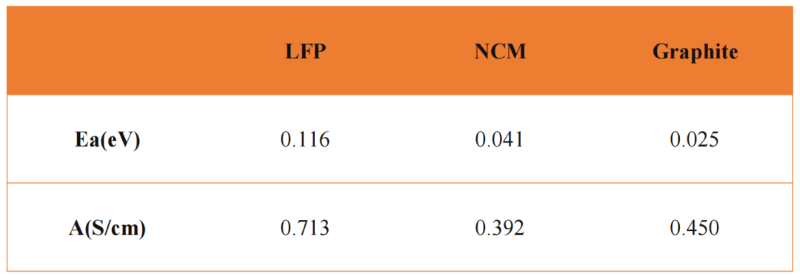
Solid-state electrolytes still face huge challenges to further improve their ionic conductivity to meet practical application requirements. Among them, the basic step of the lithium diffusion path is that Li ions migrate between two stable sites through a high-energy transition state. Reducing the transition state activation energy of the long-distance diffusion path is of great significance to improving the ionic conductivity. Therefore, for solid-state electrolyte materials, we conducted electrochemical impedance spectroscopy (EIS) tests on oxide solid-state electrolyte LATP materials at different temperatures, as shown in Figure 3(a), the Nyquist diagram shows a curve with only the ion diffusion resistance part in the low frequency region. The curve shifts significantly to the left as the temperature increases, and the ion resistance decreases with the increase in temperature.
Calculate the ionic conductivity of LATP at different temperatures, and combine the Arrhenius formula to make the corresponding linear fitting curve of lnσ and 1/T. The corresponding activation energy can be obtained through further calculations. As shown in Figure 3 (b), after calculation, the activation energy of the LATP sample is 0.044eV.
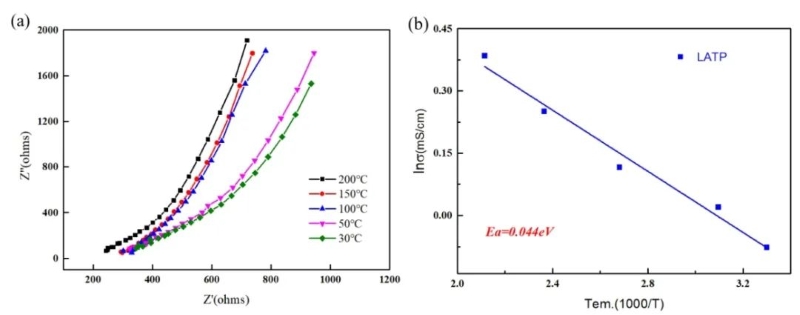
During the test process of solid electrolyte ionic conductivity, on the one hand, the density, roughness and integrity of the pressed solid electrolyte sheet will affect the test results of the solid electrolyte conductivity; on the other hand, only stable and uniform force application during the test can ensure the accuracy of the test results. The testing system for solid electrolytes independently developed by IEST can continuously and stably press solid electrolyte tablets; at the same time, it can apply stable and standardized pressure, which plays an important role in the solid electrolyte and its lithium metal battery.
3.Summary
When exploring the temperature characteristics of a material's electrical conductivity, testing the electrical conductivity of the material at different temperatures can analyze the electron/ion transport capability of the material at the current temperature point. Combined with the activation energy (activation energy) results, the changes in the intrinsic temperature characteristics of the material can be clarified, providing an effective analysis method for basic materials and engineering research, and providing the data support required for simulation calculations for relevant theoretical calculation developers. The pre-exponential factor (A) is a parameter determined by the intrinsic properties of the material, independent of temperature and substance concentration, and has the same dimensions as the property being studied (such as conductivity). The size of the pre-exponential factor is also determined by the characteristics of the material itself, which has certain research significance, and its correlation needs to be explored in depth by scientific researchers.
Reference Literature
[1] Wu Wenwei. Concise Inorganic Chemistry[M]. Chemical Industry Press, 2019.
[2] Weng S, Zhang X, Yang G, et al. Temperature-dependent interphase formation and Li+ transport in lithium metal batteries[J]. Nature communications, 2023, 14(1): 4474.
[3] Zhao Q, Liu X, Zheng J, et al. Designing electrolytes with polymerlike glass-forming properties and fast ion transport at low temperatures[J]. Proceedings of the National Academy of Sciences, 2020, 117(42): 26053-26060.

